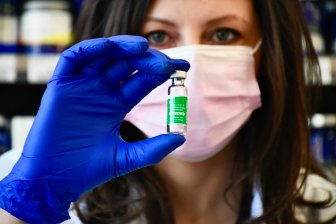A policy expert says the Canada’s Johnson & Johnson COVID-19 vaccine shipment timeline is the result of naivety and a lack of ambition, while an infectious disease physician says it won’t be the country’s ‘workhorse’ vaccine.
On Monday, Procurement Minister Anita Anand announced that the first shipments of the single-dose COVID-19 vaccine from Johnson & Johnson would arrive at the end of April. Health Canada announced approval of the vaccine March 5.
Dan Breznitz, Munk chair of innovation studies and co-director of the innovation policy lab at the Munk School of Global Affairs & Public Policy at the University of Toronto, told Global News this is the latest of various stumbles due to a late start to planning, with NACI first meeting to discuss COVID-19 in June 2020, and a lack of understanding of current world economic systems.
“In the past, you know, you had a production facility and the R&D and the design and everything in one place,” he explained.
“What we have is a world now set into slices of activities. So that product is made in various stages, if you will, around the world… it also means you have vast supply chains. Depending on where you have and those points of a supply chain, you have less or more power.”
Read more:
Amid AstraZeneca concerns, Trudeau tells Canadians to take the ‘first vaccine’ they’re offered
While he has not seen the contract that Canada has with Johnson & Johnson, he questions what incentives were provided, adding it will take months to have enough vaccine for the world and there’s “always hiccups.”
“So countries that have don’t have more than just the ‘hey, I signed that contract and I gave you some money’ — which is basically every country on earth — would be the last in the priority unless they have some other cards up their sleeves,” he said.
“We decided, A: not to have cards under our sleeves; and B: from what I understand, again, I haven’t read the contract, we really cared more about the price of the vaccine than about anything else. And that’s to me seems a bit strange.”
Canada has pre-ordered 10 million doses of the Johnson & Johnson vaccine, with options to order up to 28 million more.
On Friday, before it was announced that first shipments would arrive at the end of April, Anand said that she had repeatedly stressed the importance and necessity of Canada receiving a delivery schedule from Johnson & Johnson as soon as possible.
She added at that time that “the precise delivery schedule is one that we still need to receive and, if necessary, negotiate.”
A spokesperson for Janssen Canada, Janssen being a pharmaceutical company of Johnson & Johnson, told Global News only that it anticipates fulfilling the 10 million doses by the end of the third quarter “with first delivery targeted in the next several weeks.”
Even without the Johnson & Johnson vaccine, however, Canada is still on track to receive at least 44 million doses of COVID-19 vaccines from AstraZeneca, Moderna, and Pfizer by the end of June, though NACI is now recommending AstraZeneca’s COVID-19 vaccine not be administered to people under the age of 55.
Infectious disease physician and associate professor at McMaster University, Zain Chagla, says that when Johnson & Johnson shipments finally arrive, they will help speed up the country’s vaccination timeline, but “it’s not necessarily going to change the trajectory that much.”
“Even what we get in April is probably going to be a small amount relative, given that Johnson & Johnson is currently going to the United States, a small amount is going to Europe, South Africa has now signed a big contract for it too. We are part of the global demand for this vaccine in that sense and so we’ll get small amounts,” he told Global News.
“It’s not going to be the one that necessarily gets us to mass vaccination. It will certainly help, but this isn’t going to be the workhorse one.”
Chagla says with a month to go until the Johnson & Johnson shipments arrive, Canada should be focusing on how to make sure it gets into the right arms.
The Johnson & Johnson vaccine is the only single-dose COVID-19 vaccine approved by Health Canada and is also significantly easier to ship and store in comparison to other vaccines, as it can be kept in a refrigerator for three months.
“To me, homeless shelters, jails, high-risk workplaces — those are the places we probably should be putting this vaccine into,” Chagla explained.
“In populations where a single dose is appropriate, where they’re so transient, bringing them into a clinic is very difficult and that you could get it all done within a day or two, or at least have some doses residual for someone that shows up a week or two later into the system.”
Biolyse Pharma in St. Catharines, Ont., is hoping to obtain a compulsory licence.
supplied by Biolyse Pharma
Meanwhile, a company based out of St. Catharines, Ont., is hoping that it can add to the world’s vaccine supply through the use of a little-used mechanism that would allow it to override Johnson & Johnson’s patent and produce a generic version of the vaccine.
Biolyse Pharma, which currently produces cancer medicines, is hoping to obtain a compulsory licence through Canada’s Access to Medicines Regime, which is Canada’s legislation that reflects the World Trade Organization’s agreement on Trade-Related Aspects of Intellectual Property Rights (TRIPS).
Biolyse spokesperson John Fulton says the company could potentially produce up to 20-million doses per year.
“About four years ago we started purchasing equipment and building out a facility to produce biologic drugs. And, of course, we’re dealing with a pandemic so they decided, ‘Well, let’s get involved with this war effort and pivot to producing vaccines,’ because it’s all the same equipment.”
Specialized equipment at Biolyse Pharma.
supplied by Biolyse Pharma
He says over the last several months, Biolyse reached out to companies to see if they could work together to help produce vaccines, but didn’t get any takers. That’s when he reached out to Knowledge Ecology International (KEI) for assistance pursuing a compulsory licence.
Biolyse managed to use Canada’s Access to Medicines Regime in 2006 amid a global peak of bird flu to get a generic of Tamiflu added to a list of drugs covered under Canada’s patent act, which is among Canada’s requirements to obtain a compulsory licence.
In that case, it took roughly eight months before the patent act was amended to include oseltamivir phosphate.
Biolyese has a meeting scheduled with Health Canada in early April to discuss the application, but a researcher with KEI told Global News it’s unlikely any decision will be made at that time and it’s unclear how long the entire process will take.
It’s worth the effort, Chagla suggested, because the threat of variants and the potential need for repeat vaccinations makes for a long-term need for COVID-19 vaccine on a global scale.
“Obviously, more production, more vaccines is better. And again, Johnson & Johnson has the potential to be the global vaccine in that sense because of the one dose nature and because of the the issues of refrigeration stability. Adding to that benefit to the world is only helpful.”
Outside of the Johnson & Johnson vaccine, Breznitz is hoping that Canada will start preparing for the future now.
“We are, as always, too naive and not ambitious enough,” he said.
“Are we going to up our ante and ensure that we are — and we can be — global leaders in the production of those kinds of vaccines in this country?”
— with files from Global News’ Rachael D’Amore.
© 2021 Global News, a division of Corus Entertainment Inc.







